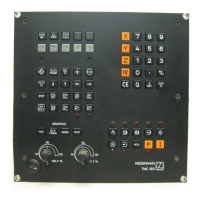DR. JOHANNES HEIDENHAIN GmbH
D-6225 Traunreut ,Tel. (08669) 31-O
SERVICE MANUAL TNC 151/155
Paae 51
Kundendienst
Se&ion 4.1
- The P.AMs -20.2- on the main ~rocsssor board con be accessed b) TNC 151/155 Q-Versions:
either by the main processor -2O- or by the CLP processor.
The intended coordinates, programed feed, display texts etc.
can therefore be transferred.
These RAMS also serve as register file memory for the main
processor -2o-.
User programs, machine parameters, and (under certain circm-
stances) the PLC program are programed in RAMS -20.4-.
- The 16-bit address bus is extended to 20-bit by a memory
mapper 1.
- The keyboard controller -22- has the task of driving the
LEDs and scanning the keypads -22.1- on the front plate.
- The main processor is connected with V.24 interface via a
(serial) CRU-bus. This interface is used to exchange data by
means of a magnetic taps unit (ME) or, respectively, an
external processor.
- The PLC program contained in IC-P9 -23.1- is processed by the
"1-bit-PLC-processor" -23- mounted discretely on the main
processor board. The input and output states are stored in a
8k x 8 PLC-RAM -23.2-.
- I/O-Functions:
a) TNC X1/155 B-Versions:
24 galvanically separated inputs (EO to E23) -5O- and 24
floating relay contact outputs (A0 to A22 + emergency stop)
-51- on the SE Board. The inputs and outputs are protected
on the terminal board (B/F version) by special protective
resistances 5.lk*-70- and 4F-70.1-.
Protective resistances should never be replaced with normal
resistances!
They are led via LC-filter -71- as protection against the
oscillation of analog outputs.
The inputs &d outputs are loaded on an external PLC
I/O-boards (e.g. PL 1OOB or, respectively, PL 100B)
which is driven by the main processor -2O- via the PLC
interface board. The data is serially transferred via
the CRU-bus.
All lines of this bus as well as the
required addresses ars galvanically separated by the
optocoupler -5O- and are converted from the TTL level
(5V) to the MOS level (12V) by means of a level converter
-51-. Thus a higher noise immunity is obtained.
Under the control of CRU addresses 63 programmable inputs
(EO to E62) -E2- located on the PLC I/O board are multi-
plexed on CRUIN 1 line. If 2 PLC I/O boards are connected
the inputs from the 2nd board are multiplexed on CRUIN 2.
On the PLC interface board either CRUIN 1 or CRUIN 2 are
selected -54- and are led to the main processor via CRUIN.
The serial CRUOUT signal is converted in 31 outputs via a
serial-parallel-converter -El.l-. The outputs (each having
its own current supervision -El-) are transferred via line
drivers to the machine interface.
- An overloaded output only switches off during the period
of the overload.
- If the current supervision detects overcurrent no
emergency-stop results in the standard PLC program.
The input E63 is used to indicate an overloaded output to
the main processor -2O-.
PL 1008: 31 unipolar, programmable outputs +
emergency-stops protected against overload.
PL 1lOB: 26 unipolar, programmable outputs + 5 bipolar
outputs protected against overload.
On the PLC I/O board a 12V voltage is generated by an
external 24V supply PIG I/O board. On the PLC interface
board this 12V voltage is transformed in a 5V voltage
for its TTL modules.

